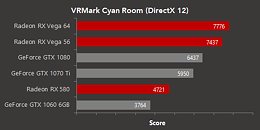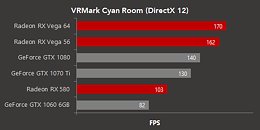Friday, November 24th 2017

AMD Radeon Graphics Cards Trump NVIDIA Alternatives in VRMark Cyan Room
Benchmarking company Futuremark has recently introduced a new benchmark to its VRMark suite, the Cyan Room, which brings the latest in rendering technologies to the VR world. Futuremark expects this test to leverage the latest hardware and software developments in DX12 to better utilize today's GPUs still somewhat untapped power. In something of a plot twist, AMD's Radeon architectures (in the form of Polaris 20-based RX 580 and Vega-based RX Vega 56 and RX Vega 64) trump NVIDIA's equivalent offerings in pure performance numbers.
Testing was performed by pairing a Ryzen 7 1800X CPU with a selection of graphics cards from both AMD and NVIDIA, supported by 16GB of DDR4-2933 system memory, and Windows 10 x64. In a post on Radeon gaming, Scott Wasson said that "The Cyan Room (...) highlights AMD's continued performance leadership on this (VR) front," adding that "the Radeon GPUs we tested have clear leads over their direct competition. What's more, all the Radeon GPUs are meeting the key requirement for today's VR headsets by delivering at least 90 frames per second in this test."Which is true, hands-down: it's just a matter of looking at those AMD internal test numbers, where the RX Vega 56, which usually trades blows with the GTX 1070 Ti, is seen far ahead of NVIDIA's GTX 1080 graphics cards. An equally impressive showing is delivered by AMD's RX 580, which leads its NVIDIA competitor, the GTX 1060 6 GB, by a wide as margin as the Vega-based cards. This is impressive, to say the least, and a far-cry from what we're used to seeing from the AMD camp this generation, at least when it comes to pure frame rate competitiveness.
Source:
Radeon Gaming
Testing was performed by pairing a Ryzen 7 1800X CPU with a selection of graphics cards from both AMD and NVIDIA, supported by 16GB of DDR4-2933 system memory, and Windows 10 x64. In a post on Radeon gaming, Scott Wasson said that "The Cyan Room (...) highlights AMD's continued performance leadership on this (VR) front," adding that "the Radeon GPUs we tested have clear leads over their direct competition. What's more, all the Radeon GPUs are meeting the key requirement for today's VR headsets by delivering at least 90 frames per second in this test."Which is true, hands-down: it's just a matter of looking at those AMD internal test numbers, where the RX Vega 56, which usually trades blows with the GTX 1070 Ti, is seen far ahead of NVIDIA's GTX 1080 graphics cards. An equally impressive showing is delivered by AMD's RX 580, which leads its NVIDIA competitor, the GTX 1060 6 GB, by a wide as margin as the Vega-based cards. This is impressive, to say the least, and a far-cry from what we're used to seeing from the AMD camp this generation, at least when it comes to pure frame rate competitiveness.



23 Comments on AMD Radeon Graphics Cards Trump NVIDIA Alternatives in VRMark Cyan Room
www.3dmark.com/vrpcr/4256
Cost is the leveller though so it's good to see the 64 card soundly winning against the 1080 but still....
For ref: Vulkan
HERE
Oh well, no news here.
Just a guess here, but if this is same story as latest dx12 games nvidia might slack off with a slower CPU and will gain the lost ground once paired with 7700K or faster.
I think in this case $50 is definitely worth the 20-25% performance bump (even in non-conventional VR benchmarks).
Also, Cyan Room is relatively new and was purposefully selected to showcase this "advantage".
VRMark Orange Room and more demanding Blue Room tell the whole different story (check HWBot or 3DMark rankings).
Meanwhile Nvidia works better for the other 99%.
That said, if you're an enthusiast, DX12 and VR may be exactly your thing, so I have no problem with hardware being shown/benchmarked from different angles. As long as we understand the point of view.
btw, anyone with a VR headset ought to try out the Cyan room VR experience. Nice...